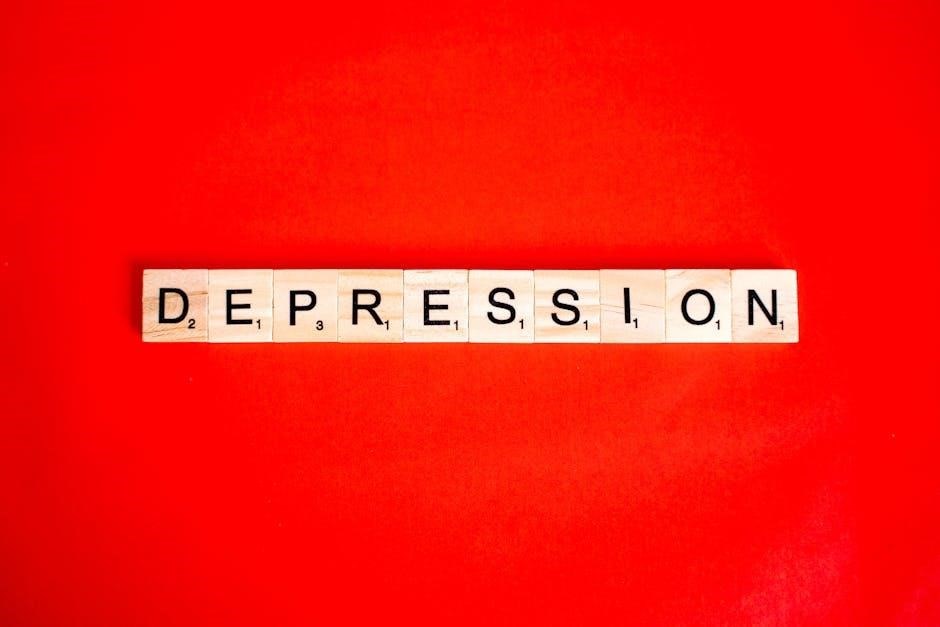The Liebowitz Social Anxiety Scale (LSAS) is a 24-item clinician-administered instrument designed to assess social anxiety disorder․ It evaluates fear and avoidance across social situations, providing a reliable and valid measure for diagnosis and treatment monitoring․ Widely used in clinical and research settings, the LSAS is recognized for its treatment sensitivity and ability to differentiate social anxiety from other disorders․
1․1 Overview of the LSAS
The Liebowitz Social Anxiety Scale (LSAS) is a 24-item clinician-administered instrument designed to assess social anxiety disorder․ It evaluates fear and avoidance across various social situations, such as public speaking, eating in public, and telephoning in public․ Each item is rated on a 0-3 scale, measuring the severity of anxiety and avoidance․ The LSAS is widely used in clinical and research settings to understand the impact of social phobia on daily life, providing a comprehensive overview of symptoms and their effects․
1․2 Importance of the LSAS in Assessing Social Anxiety
The LSAS is crucial for accurately diagnosing and managing social anxiety disorder․ It provides a detailed assessment of fear and avoidance behaviors, aiding clinicians in understanding symptom severity․ The scale’s ability to differentiate social anxiety from other disorders ensures precise diagnosis․ Its treatment sensitivity allows monitoring of progress, making it a valuable tool in both clinical practice and research, enhancing the effectiveness of therapeutic interventions for individuals with social anxiety․

History and Development of the LSAS
Developed by Michael R․ Liebowitz in 1987, the LSAS was created to assess social anxiety symptoms․ It has since become a widely used tool in clinical settings․
2․1 Creation by Michael R․ Liebowitz
Michael R․ Liebowitz developed the LSAS in 1987 to evaluate social anxiety symptoms․ His work laid the foundation for standardized assessment, aiding diagnosis and treatment․ The scale’s creation marked a significant advancement in mental health evaluation, providing a structured approach to measure fear and avoidance in social contexts․ Liebowitz’s contribution remains integral to modern clinical practice and research in social anxiety disorder․
2․2 Evolution of the Scale Over Time
The LSAS has undergone refinement since its introduction in 1987․ Initially developed by Michael Liebowitz, it has been validated and adapted for cross-cultural use․ Over time, its structure has remained consistent, but its application has expanded․ The scale has been translated into multiple languages and adapted for self-reporting, enhancing accessibility․ Its evolution reflects ongoing research, ensuring it remains a robust tool for assessing social anxiety globally․ These updates have solidified its role in clinical and research settings․

Structure of the LSAS
The LSAS consists of 24 items assessing social anxiety across situations․ It includes subscales for fear and avoidance, each rated on a 4-point severity scale․ Scoring ranges from 0 to 3, with higher totals indicating greater impairment․ This structure allows for comprehensive evaluation of social anxiety symptoms, providing valuable insights into both emotional and behavioral aspects․ Its clear format ensures reliable data collection and interpretation․
3․1 Number of Items and Subscales
The Liebowitz Social Anxiety Scale (LSAS) contains 24 items, divided into two subscales: 13 items assess fear in social interactions and 11 items evaluate avoidance behaviors․ Each item is rated on a 4-point scale, ranging from 0 (none) to 3 (severe)․ This structure allows for a detailed assessment of both the emotional and behavioral components of social anxiety, providing a comprehensive understanding of how social phobia impacts daily life․ The subscales are designed to capture the full spectrum of social anxiety manifestations․
3․2 Differentiation Between Fear and Avoidance
The LSAS distinguishes between fear and avoidance, with separate ratings for each social situation․ Fear is assessed on a 4-point scale (0-3), reflecting emotional distress, while avoidance is similarly rated, indicating behavioral responses․ This differentiation allows clinicians to understand both the emotional and behavioral components of social anxiety, providing a nuanced evaluation․ By separating these aspects, the scale offers a clearer picture of how social anxiety manifests, aiding in targeted interventions and personalized treatment plans․
3․3 Scoring System and Interpretation
The LSAS scoring system involves rating 24 social situations on a 4-point scale (0-3) for both fear and avoidance․ Total scores range from 0 to 144, with higher scores indicating greater severity․ Fear and avoidance ratings are often correlated but provide distinct insights․ Clinicians interpret scores to assess symptom severity and monitor changes over time, aiding in diagnosing social anxiety disorder and evaluating treatment response․ This dual assessment enhances understanding of both emotional and behavioral aspects of social anxiety, guiding targeted interventions․

Validation and Reliability of the LSAS
The LSAS is a reliable and valid measure of social anxiety, demonstrating strong internal consistency and treatment sensitivity․ Studies confirm its robust psychometric properties across diverse samples․
4․1 Reliability and Internal Consistency
The LSAS demonstrates strong internal consistency, with high reliability across clinical and non-clinical populations․ Its robust psychometric properties ensure consistent measurement of social anxiety symptoms, making it a dependable tool for assessments and research․
4․2 Validity and Cross-Cultural Adaptations
The LSAS has demonstrated strong validity in assessing social anxiety across diverse populations․ Cross-cultural adaptations, such as the Russian version by I․V․ Grigorieva, highlight its applicability worldwide․ Validation studies, including one involving 179 participants, confirm its effectiveness in measuring anxiety levels consistently․ These adaptations ensure the scale remains a reliable tool for assessing social anxiety in different cultural contexts, maintaining its relevance for global research and clinical use․
4․3 Treatment Sensitivity of the Scale
The LSAS is highly sensitive to changes in social anxiety symptoms, making it an effective tool for monitoring treatment progress․ Studies show significant reductions in LSAS scores following interventions, indicating its ability to track improvements․ This sensitivity allows clinicians to evaluate the efficacy of therapies and adjust treatment plans accordingly․ Its responsiveness to change enhances its utility in both clinical practice and research, providing a clear measure of treatment outcomes for individuals with social anxiety disorder․

Clinical Applications of the LSAS
The LSAS is widely used in clinical settings to assess social anxiety, monitor treatment progress, and differentiate it from other anxiety disorders, ensuring accurate diagnosis and effective therapy․
5․1 Diagnosis of Social Anxiety Disorder
The LSAS is a crucial tool for diagnosing social anxiety disorder, assessing fear and avoidance in various social situations․ Its 24 items, rated on anxiety and avoidance scales, help clinicians identify symptom severity․ High scores indicate significant impairment, aligning with DSM-5 criteria․ The scale’s reliability and validity make it a standard in clinical practice for accurately detecting social anxiety and distinguishing it from other disorders, ensuring precise diagnosis and tailored treatment plans․
5․2 Monitoring Treatment Progress
The LSAS is widely used to monitor treatment progress in individuals with social anxiety disorder․ By regularly administering the scale, clinicians can track changes in fear and avoidance levels, providing insight into the effectiveness of interventions․ Its sensitivity to treatment effects allows for timely adjustments to therapy plans, ensuring personalized and adaptive care․ This tool is invaluable for assessing progress and informing clinical decisions throughout the treatment journey․
5․3 Differentiation from Other Anxiety Disorders
The LSAS helps differentiate social anxiety disorder from other anxiety disorders by specifically targeting fears and avoidances related to social interactions and performance․ Unlike generalized anxiety or panic disorder, the LSAS focuses on situations involving social evaluation, such as public speaking or meeting new people․ This specificity allows clinicians to accurately diagnose and tailor treatments, ensuring targeted interventions for social anxiety while distinguishing it from other conditions with overlapping symptoms․

Practical Uses of the LSAS
The LSAS is a versatile tool for self-assessment, research, and therapy․ It helps individuals monitor progress, aids in studies, and supports treatment planning effectively․
6․1 Self-Assessment for Individuals
Individuals can use the LSAS to identify and monitor their social anxiety symptoms․ The scale provides insights into specific situations triggering fear and avoidance, enabling self-awareness․ By rating their anxiety and avoidance levels, individuals can track changes over time, fostering personal growth and informed decision-making․ This self-assessment tool empowers users to understand their condition better and seek appropriate interventions, making it a valuable resource for personal mental health management․
6․2 Use in Research Studies
The LSAS is widely used in research to assess social anxiety symptoms and treatment effectiveness․ Studies often employ the scale to evaluate fear and avoidance across diverse populations․ Validation studies, such as those involving 179 participants, demonstrate its reliability․ Research highlights its sensitivity in detecting changes, making it ideal for clinical trials․ The LSAS also aids in exploring comorbidity with other disorders, enhancing understanding of social anxiety’s complexities and supporting evidence-based interventions․
6․3 Integration into Therapy Plans
The LSAS is a valuable tool in therapy, allowing clinicians to tailor interventions to specific symptoms․ By identifying situations that trigger fear and avoidance, therapists can develop targeted strategies․ Regular administration of the LSAS helps monitor progress, enabling adjustments to treatment plans․ This scale also aids in setting realistic goals and provides patients with clear feedback, fostering collaboration between therapist and client․ Its integration enhances the effectiveness of cognitive-behavioral therapy and other evidence-based approaches for social anxiety disorder․

Limitations of the LSAS
The LSAS has several limitations, including its reliance on self-reported data, which can introduce bias and inaccuracy․ Cultural biases may exist due to its development in specific cultural contexts․ Additionally, the scale requires professional administration, limiting accessibility for those without access to mental health professionals․ The fixed set of questions may not capture the full range of social anxiety experiences, and its focus on fear and avoidance may overlook other factors or comorbid conditions․ These limitations should be considered when using the LSAS in clinical or research settings․
7․1 Subjective Nature of Responses
The LSAS relies on self-reported responses, which are inherently subjective․ This can lead to inconsistencies, as individuals may underreport or overreport symptoms based on their personal perceptions․ The scale’s accuracy depends on the honesty and self-awareness of the respondent, introducing potential biases․ Cultural differences and personal interpretations of social situations can also affect responses, making it challenging to ensure objectivity․ This subjective nature highlights the need for skilled interpretation by professionals to accurately assess social anxiety severity․
7․2 Potential Cultural Biases
The LSAS may exhibit cultural biases due to differences in social norms and expressions of anxiety across cultures․ While it has been validated in some cross-cultural studies, variations in societal expectations and communication styles can affect how individuals interpret and respond to items․ For example, certain social situations deemed anxiety-provoking in one culture may not be perceived similarly in another․ These differences can lead to inconsistent measurements and limit the scale’s universal applicability without cultural adaptations․
7․3 Need for Professional Administration
The LSAS requires professional administration to ensure accurate assessment and interpretation․ Trained clinicians can guide respondents in understanding items and provide context, minimizing misinterpretation․ Self-administration may lead to incomplete or inaccurate responses, as individuals might underreport symptoms or misunderstand the severity scale․ Professional oversight ensures consistency, reliability, and validity, making it essential for clinical and research applications to rely on skilled administrators for optimal results․

Future Directions for the LSAS
Future directions include expanding online accessibility, enhancing cross-cultural adaptations, and integrating with other assessment tools to improve its utility in diverse clinical and research settings globally․
8․1 Technological Advances in Administration
Technological advancements are transforming the administration of the LSAS, enabling digital and online platforms for remote assessment․ Mobile apps and AI-driven scoring systems enhance accessibility and efficiency․ Virtual reality (VR) integration could simulate social scenarios for real-time evaluation․ These innovations ensure the LSAS remains a cutting-edge tool, facilitating accurate and timely assessments in diverse settings while maintaining reliability and validity in the digital age․
8․2 Expanding Cross-Cultural Validity
Efforts to expand the LSAS’s cross-cultural validity involve adapting the scale for diverse populations․ Collaborations with international researchers ensure the tool is culturally sensitive and relevant․ Translations and validations in languages like Russian demonstrate its global applicability․ These adaptations enable accurate assessments of social anxiety across different cultural contexts, ensuring the LSAS remains a universally effective diagnostic instrument․ Ongoing research focuses on further refining its cross-cultural relevance to meet the needs of diverse populations worldwide․
8․3 Integration with Other Assessment Tools
Future directions include integrating the LSAS with other assessment tools to enhance diagnostic accuracy․ By combining it with instruments like the Fear of Negative Evaluation Scale, a more comprehensive understanding of social anxiety can be achieved․ Such integration allows clinicians to identify comorbid conditions and tailor treatments more effectively․ This multimodal approach ensures a holistic evaluation of social anxiety, improving both research and clinical outcomes․ The goal is to create a unified framework for assessing social anxiety disorders․
The Liebowitz Social Anxiety Scale remains a cornerstone in assessing social anxiety, offering reliable and valid measurements․ Its impact on diagnosis and treatment is undeniable, ensuring continued relevance and future advancements in mental health care․

9․1 Summary of the LSAS’s Significance
The Liebowitz Social Anxiety Scale (LSAS) is a cornerstone in assessing social anxiety, offering a reliable and valid measure of fear and avoidance in social situations․ Its ability to distinguish between fear and avoidance, coupled with its sensitivity to treatment outcomes, makes it invaluable for clinicians and researchers․ Widely used globally, the LSAS has been adapted cross-culturally, ensuring its applicability in diverse populations․ Its significance lies in its comprehensive assessment of social anxiety, aiding in diagnosis, treatment monitoring, and differentiation from other anxiety disorders, thus remaining a critical tool in mental health care․
9․2 Final Thoughts on Its Impact and Future
The Liebowitz Social Anxiety Scale (LSAS) remains a cornerstone in mental health assessment, offering profound insights into social anxiety․ Its adaptability to technological advancements, such as digital administration, ensures its relevance in modern clinical practice․ Future directions may include enhanced cross-cultural validity and integration with other assessment tools, further solidifying its role in global mental health care․ The LSAS’s continued evolution promises to aid in refining treatments and advancing research, ensuring its lasting impact on understanding and addressing social anxiety disorder․

References and Further Reading
Key resources include the original LSAS publication by Liebowitz (1987) and adaptations by researchers like Grigorieva․ Additional materials are available as downloadable PDFs for deeper understanding․
10․1 Key Publications on the LSAS
Key publications on the LSAS include the original 1987 paper by Liebowitz, detailing its development and validation․ Adaptations, such as Grigorieva’s Russian version, expand its reach․ Research by Heimberg et al․ (1999) highlights the scale’s reliability․ These works, along with downloadable PDF resources, provide comprehensive insights into the LSAS’s structure, application, and cross-cultural validity, making them essential references for both clinicians and researchers․
10․2 Available PDF Resources for Download
Several PDF resources on the LSAS are available for download, including the original questionnaire, validation studies, and cultural adaptations․ The full-scale PDF provides detailed instructions for administration and scoring․ Additional resources include translations, such as the Russian version by Grigorieva, and research articles discussing its reliability․ These downloadable materials are accessible through various academic and clinical websites, offering comprehensive tools for both professionals and researchers to utilize the LSAS effectively in diverse settings․
10․3 Recommended Reading for Deeper Understanding
For in-depth insights, key publications include Michael R․ Liebowitz’s original 1987 paper on the LSAS and Heimberg et al․’s 1999 validation studies․ Grigorieva’s 2016 research on cultural adaptations and Taylor’s Manifest Anxiety Scale comparisons also provide valuable context․ These resources, available as PDFs, offer comprehensive understanding of the LSAS’s development, validation, and clinical applications, making them essential reading for researchers and professionals seeking to fully grasp the scale’s utility and significance in assessing social anxiety․
